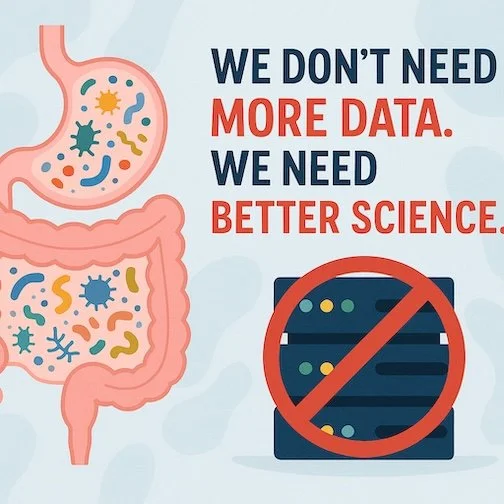The Microbiome as Commodity: Why the Viome and Microsoft Partnership Demands Scientific Vigilance
There’s no doubt the human microbiome is one of the most exciting frontiers in health research today. We’ve come a long way in understanding how this ecosystem of bacteria, viruses, fungi, and other microbes interacts with our immune system, metabolism, and even mental health. It’s complex, dynamic, and highly individualized. So it makes sense that companies want to harness this information and turn it into something actionable.
Viome, one of the more prominent players in this space, has recently partnered with Microsoft to scale its data infrastructure and analysis capacity. That might sound like a step forward, but as someone who has spent nearly two decades studying the microbiome and human health, I think we need to pause and ask some hard questions.
This isn’t just about gut health. It’s about scientific responsibility, regulatory oversight, and whether the underlying evidence is strong enough to support the claims being made.
The Reality of Microbiome Science
The microbiome is often talked about like a fingerprint, something unique and stable you can measure once and use to make long-term health decisions. But that’s not how it works.
The microbiome is more like the ocean. If you take a photo of the ocean right now, you can see that it’s the ocean. You can spot the waves, maybe even a pattern or two. But if you take another photo a few minutes later, it’s going to look different. The lights changed. The ripples have shifted. Maybe a boat passed through or the wind picked up. If you take another photo right after that, it’s changed again. Each image still shows you the ocean, but none of them fully captures what’s going on beneath the surface, or how it might look ten minutes from now.
That’s exactly what we’re doing when we take a single microbiome sample. It’s a snapshot of something that is constantly shifting, based on diet, stress, medications, sleep, exercise, travel, and even the time of day. You can identify broad trends, but drawing precise, individual conclusions from one sample is risky. When companies start using this kind of data to tell people how to eat, what supplements to take, or how fast they’re aging, we need to be really honest about the limitations of that information.
Viome claims to solve this by analyzing RNA expression instead of DNA. The idea is that RNA gives a more active, real-time view of what’s happening in your gut and your cells. That’s an interesting approach, but RNA is unstable. It degrades easily, it’s highly sensitive to how the sample is collected and processed, and it can be heavily influenced by short-term variables. You have to ask yourself, “Are we getting real biological insight or just another blurry photo of the ocean?”
Proprietary Algorithms and Unanswered Questions
Viome sells a lot of confidence. Their platform gives users food recommendations, biological aging scores, and supplement plans based on their microbiome and host gene expression. The problem is that the science behind those recommendations isn’t transparent.
The core algorithms they use are proprietary. Most of the studies validating their approach are either internal or not peer-reviewed. There’s very little independent data confirming that their tests do what they say they do. And their most talked-about product, a test for early-stage oral and throat cancer, hasn’t been approved by the FDA. It’s been granted a “Breakthrough Device” designation, which is not the same thing.
If you’re going to make health claims that affect what people eat, how they think about their aging, or whether they take a certain supplement, the science behind it needs to be rock solid. Otherwise, we’re not dealing with personalized medicine. We’re dealing with customized marketing.
Scaling Without Scientific Foundation
Microsoft’s role in this is to help Viome scale. More data, faster processing, better infrastructure. That’s all well and good, but scale doesn’t fix scientific problems. If anything, it can make them worse.
In microbiome science, more data doesn’t always mean better insight. If the metadata is thin or inconsistent, or if the sample collection isn’t standardized, you end up with noise. You see patterns that might not mean anything. And when you start drawing health conclusions from those patterns, the risk of misleading people goes way up.
There’s also the issue of generalizability. Many of these algorithms are trained on Viome’s data, which may not represent the broader population. If they haven’t been validated in diverse groups or tested across different health conditions, the recommendations may not be relevant or even safe for everyone.
What We Need Instead
I’m not against innovation, and I absolutely believe in the promise of the microbiome. I’ve dedicated my career to it. But I also believe in accountability. If companies want to play in the healthcare space, especially at this scale, they have to operate like healthcare companies, not tech startups.
That means:
· Make their methods transparent so other scientists can test and refine them.
· Allow access to raw data, with clear consent protocols for secondary use.
· Publish in peer-reviewed journals, not just internal white papers or marketing blogs.
· Collect rich contextual metadata to make their findings biologically meaningful.
· Avoid overpromising outcomes that are not yet supported by clinical trials.
It’s not about being slow or cautious for the sake of it. It’s about protecting people from the hype that outpaces the science.
Final Thoughts
The microbiome is not a gimmick. It’s one of the most powerful systems we have for understanding health and disease. But when we start turning it into a consumer product without adequate testing or oversight, we risk eroding trust in the entire field.
The Viome and Microsoft partnership may sound like progress. But if the foundation isn’t solid, if the science isn’t replicable and the methods aren’t transparent, then it’s just a bigger, faster version of the same problem.
We don’t need more data. We need better science.

